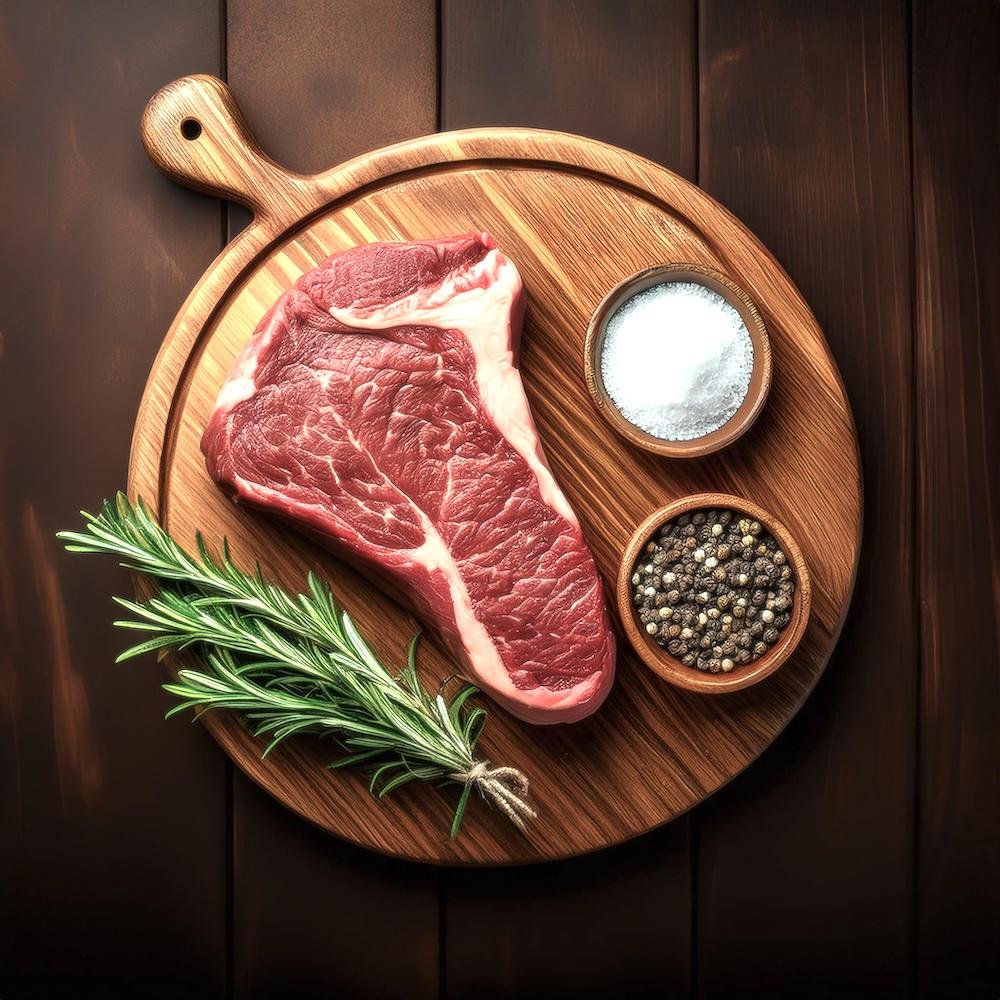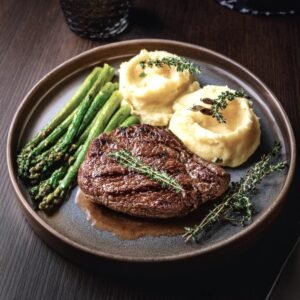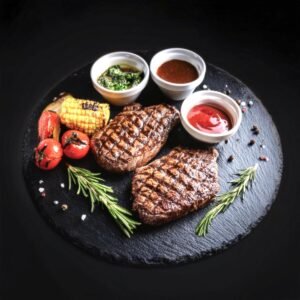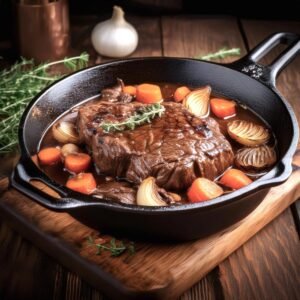When it comes to steak, ribeye is a go-to choice for its exceptional tenderness and rich marbling. However, chuck eye steak, often called the “poor man’s ribeye,” is a lesser-known alternative that offers similar qualities at a more affordable price.
Both cuts are prized for their flavor, but they differ in texture, tenderness, and cost. Understanding these differences can help you decide which steak is best suited for your next meal, whether you’re grilling for a special occasion or preparing a weeknight dinner.
In this article, we’ll break down the similarities and differences between chuck eye steak and ribeye, exploring their origins, characteristics, and best uses in the kitchen.
What Is Chuck Eye Steak?
Chuck eye steak is a cut of beef taken from the chuck primal, specifically from the shoulder area of the cow. It’s located near the rib primal, which explains its similarities to ribeye in terms of flavor and marbling.
Characteristics of Chuck Eye Steak
- Location on the Cow:
- Cut from the 5th rib, just before the ribeye section begins (6th–12th ribs).
- This proximity gives it a marbling pattern and flavor profile reminiscent of ribeye.
- Flavor Profile:
- Chuck eye steak is rich and beefy, with a bold taste that’s enhanced when grilled or pan-seared.
- Texture:
- Slightly less tender than ribeye due to its closer connection to the shoulder muscles.
- Contains small amounts of connective tissue, which can be mitigated with proper cooking techniques.
- Affordability:
- Often more budget-friendly than ribeye, making it an attractive option for steak lovers on a budget.
What Is Ribeye?
Ribeye is one of the most sought-after cuts of beef, celebrated for its exceptional tenderness, rich marbling, and robust flavor. Often considered a premium steakhouse cut, ribeye is a favorite for grilling, pan-searing, and other high-heat cooking methods.
Characteristics of Ribeye
- Location on the Cow:
- Ribeye is cut from the rib primal, specifically from the 6th to the 12th ribs.
- This area is less worked by the cow, resulting in tender meat with well-distributed marbling.
- Flavor Profile:
- Ribeye is known for its buttery, beefy flavor that’s enhanced by the natural marbling of fat within the meat.
- The high-fat content gives it a melt-in-your-mouth quality when cooked to perfection.
- Texture:
- Incredibly tender due to its location on the cow and the absence of heavy connective tissue.
- The meat’s juiciness and softness make it ideal for high-heat cooking methods like grilling or broiling.
- Premium Status:
- Ribeye is considered a luxury cut, often commanding a higher price than other steaks due to its quality and popularity.
Bone-In vs. Boneless Ribeye
- Bone-In Ribeye:
- Includes the rib bone, which some believe enhances the flavor during cooking.
- Often referred to as a “cowboy steak” when cut thick with the bone intact.
- Boneless Ribeye:
- Easier to cook evenly and slice, making it a more convenient option for many home cooks.
Pro Tip: For maximum flavor, opt for a bone-in ribeye and cook it to medium-rare to preserve its tenderness and juiciness.
Similarities Between Chuck Eye Steak and Ribeye
Chuck eye steak and ribeye share several similarities due to their close proximity on the cow. These shared traits make chuck eye steak a fantastic alternative for ribeye lovers looking for a budget-friendly option.
1. Proximity on the Cow
- Close Neighbors:
- Chuck eye steak is cut from the 5th rib, directly adjacent to the ribeye section (6th–12th ribs).
- This positioning gives chuck eye steak a flavor profile and marbling pattern similar to ribeye.
Pro Tip: The first few chuck eye steaks cut closest to the rib primal are often referred to as the “poor man’s ribeye” because of their similarity to the premium cut.
2. Rich Marbling
- Flavorful Fat Distribution:
- Both cuts feature significant marbling, which enhances their rich, beefy flavor and juiciness.
- While ribeye generally has more consistent marbling, chuck eye steak still delivers a hearty, steakhouse-quality taste.
Pro Tip: To maximize flavor, sear both cuts at high heat to caramelize the marbling and create a flavorful crust.
3. Cooking Versatility
- High-Heat Methods:
- Both cuts perform well when grilled, pan-seared, or broiled.
- The marbling ensures that they stay juicy and flavorful even with high-heat cooking.
- Flavor Pairings:
- Both steaks pair well with simple seasonings like salt, pepper, and garlic, or more complex flavors like herb butters and spice rubs.
Pro Tip: Chuck eye steak may require tenderizing or marinating before cooking, unlike ribeye, which is naturally tender.
4. Bold, Beefy Flavor
- Signature Steakhouse Taste:
- Chuck eye steak and ribeye are both celebrated for their robust beef flavor, making them ideal for steak lovers.
- When cooked properly, chuck eye steak can closely mimic the flavor of ribeye.
Pro Tip: For the best results, cook both cuts to medium-rare or medium to preserve their juiciness and flavor.
Key Differences Between Chuck Eye Steak and Ribeye
While chuck eye steak and ribeye share similarities, there are key differences that impact their texture, tenderness, cost, and ideal uses. Understanding these distinctions can help you choose the right cut for your needs.
1. Tenderness and Texture
- Ribeye:
- Renowned for its buttery tenderness, ribeye is one of the most tender cuts of beef.
- The fat distribution and absence of connective tissue make it perfect for high-heat cooking methods.
- Chuck Eye Steak:
- Slightly less tender than ribeye due to its location closer to the shoulder, which has more connective tissue.
- It has a firmer texture but can still be tender when cooked properly.
Pro Tip: Marinate chuck eye steak to enhance tenderness or use slower cooking methods like braising if the cut is thicker or tougher.
2. Cost Comparison
- Ribeye:
- A premium steak, ribeye is more expensive due to its tenderness and widespread popularity.
- Prices often reflect its status as a steakhouse favorite.
- Chuck Eye Steak:
- A budget-friendly alternative to ribeye, chuck eye steak provides similar flavor at a fraction of the cost.
Pro Tip: If you’re cooking for a large group or on a budget, chuck eye steak delivers excellent value without sacrificing flavor.
3. Versatility in Cooking
- Ribeye:
- Best suited for high-heat methods like grilling, broiling, or pan-searing to highlight its natural tenderness.
- Rarely requires tenderizing or marinating due to its texture.
- Chuck Eye Steak:
- Versatile enough for grilling, pan-searing, or slow-cooking, depending on the cut’s thickness and marbling.
- Often benefits from marinating or tenderizing to maximize flavor and texture.
Pro Tip: For quick meals, opt for chuck eye steak cuts closest to the rib primal, as they are naturally more tender.
4. Availability
- Ribeye:
- Widely available in grocery stores, butcher shops, and restaurants.
- Typically offered in a variety of styles, including bone-in and boneless.
- Chuck Eye Steak:
- Less commonly found in large quantities, as only a few chuck eye steaks come from each cow.
- May be labeled as “mock ribeye” or included in the chuck section at grocery stores.
Pro Tip: Ask your butcher for chuck eye steak if you don’t see it displayed—it’s worth the hunt!
When to Choose Chuck Eye vs. Ribeye
Both chuck eye steak and ribeye have their strengths, making them suited for different occasions and preferences. Here’s how to decide which one to use based on your needs.
When to Choose Chuck Eye Steak
- Budget-Friendly Meals:
- Ideal for steak lovers seeking a ribeye-like flavor without the premium price tag.
- Perfect for weeknight dinners, family meals, or casual gatherings.
- Cooking for a Crowd:
- Chuck eye steak’s affordability makes it a great option for feeding a group without overspending.
- Recipes with Bold Flavors:
- Works well in recipes that include marinades, spice rubs, or sauces to enhance its flavor.
- Suitable for steak fajitas, stir-fries, or tacos when sliced thinly against the grain.
Pro Tip: Tenderize chuck eye steak with a marinade or mallet before grilling for the best results.
When to Choose Ribeye
- Special Occasions:
- Ribeye’s luxurious tenderness and rich marbling make it a showstopper for celebrations, date nights, or steakhouse-style meals at home.
- Minimal Preparation:
- Ideal for quick, straightforward cooking methods like grilling or pan-searing without the need for tenderizing or marinating.
- Steakhouse Experience:
- Ribeye delivers a premium steakhouse flavor and texture, perfect for impressing guests.
Pro Tip: Serve ribeye with simple seasonings to highlight its natural flavor and pair it with classic sides like baked potatoes or roasted asparagus.
Best Cooking Methods for Each Cut
- Chuck Eye Steak:
- Grilling: High heat creates a flavorful crust.
- Braising: Slow cooking tenderizes tougher cuts.
- Pan-Searing: Ideal for thinner cuts when tenderized beforehand.
- Ribeye:
- Grilling: Highlights its rich marbling and caramelizes the surface.
- Broiling: Perfect for an evenly cooked, tender steak.
- Pan-Searing: Creates a buttery crust that locks in juiciness.
Pro Tip: For both cuts, always rest the steak for 5–10 minutes after cooking to preserve juiciness.
FAQs Is Chuck Eye Steak the Same as Ribeye?
Which Is Better: Chuck Eye or Ribeye?
Ribeye: Ribeye is the superior choice for tenderness and rich marbling, making it ideal for special occasions or when you want a luxurious steakhouse experience.
It requires minimal preparation and delivers melt-in-your-mouth texture.
Chuck Eye: Chuck eye steak is a budget-friendly alternative to ribeye, offering a similar beefy flavor at a lower cost.
While slightly less tender, it can still be delicious when prepared with tenderizing techniques like marinating or slow cooking.
Verdict: Choose ribeye for premium occasions and chuck eye for everyday meals without compromising on flavor.
What Is the Poor Man’s Ribeye Cut?
Chuck Eye Steak: Often called the “poor man’s ribeye,” this cut comes from the 5th rib, located adjacent to the ribeye section.
It shares many of ribeye’s qualities, such as rich marbling and a bold flavor, but is more affordable due to its slightly firmer texture.
Pro Tip: Look for chuck eye steaks labeled as “Delmonico steak” or “mock ribeye” at your local butcher or grocery store.
What Is Another Name for Chuck Eye Steak?
Common Names: Delmonico steak
Mock ribeye
Chuck filet
Pro Tip: If you don’t see chuck eye steak labeled directly, ask your butcher for the first few chuck steaks cut closest to the ribeye section for the best quality.
Why Is Chuck Cheaper Than Ribeye?
Location on the Cow: Chuck steak comes from the shoulder area, which is more heavily worked by the cow. This results in more connective tissue and a slightly tougher texture, reducing its market value.
Limited Quantity of Premium Cuts: While ribeye is cut from a prime section (ribs 6–12), chuck provides more steaks per cow, making it less scarce and therefore less expensive.
Perceived Quality: Ribeye’s reputation as a premium steak elevates its price, while chuck steak is often marketed as a versatile, everyday cut.
Pro Tip: Despite its lower price, chuck steak delivers excellent flavor and value, especially when cooked with methods like braising or marinating.
Suggested Internal Links:
- What’s the Best Way to Cook Chuck Eye?
Explore ideal cooking techniques for maximizing the flavor and tenderness of chuck eye steak. - How Is Chuck Steak Best Cooked?
Discover the best preparation methods for various chuck cuts, including slow-cooking and grilling. - What Does a Crookie Taste Like?
Compare the distinctiveness of savory and sweet treats like chuck steak and crookies for a complete culinary experience. - Is Beef Chorizo Healthy?
Dive into the health aspects of different beef cuts, including chuck eye steak and chorizo. - Garlic Parmesan Chicken Pasta
Pair your steak with a creamy pasta recipe for a hearty and satisfying meal.
Conclusion
Chuck eye steak and ribeye may come from neighboring sections of the cow, but they each bring unique qualities to the table. Ribeye is a luxurious, tender cut that’s perfect for special occasions and steakhouse-style meals, while chuck eye steak offers a more affordable alternative with a similarly bold flavor.
Although chuck eye steak requires a bit more preparation to achieve tenderness, its versatility and cost-effectiveness make it a great choice for everyday meals. Whether you’re grilling, pan-searing, or braising, both cuts deliver satisfying results when cooked properly.
The next time you’re at the butcher or planning your dinner menu, consider whether you’re in the mood for ribeye’s indulgent texture or chuck eye steak’s hearty flavor. Either way, you’re guaranteed a delicious steak experience.
Discover more mouthwatering recipes on our Web Site ! Stay connected and get inspired by following us on Facebook, Instagram, Pinterest, and Twitter for the latest updates!




